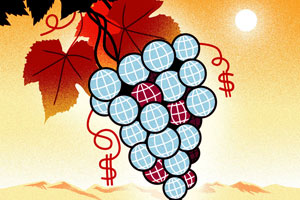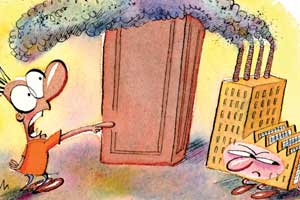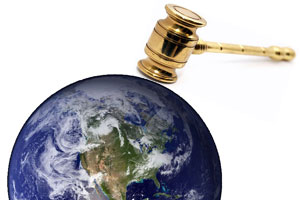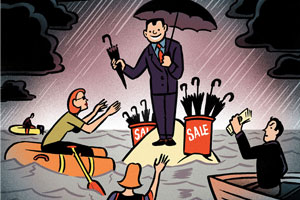
Illustration: Christoph Hitz
JOHN WILLIAMS has been making wine in California’s Napa Valley for nearly 30 years, and he farms so ecologically that his peers call him Mr. Green. But if you ask him how climate change will affect Napa’s world-famous wines, he gets irritated, almost insulted. “You know, I’ve been getting that question a lot recently, and I feel we need to keep this issue in perspective,” he told me. “When I hear about global warming in the news, I hear that it’s going to melt the Arctic, inundate coastal cities, displace millions and millions of people, spread tropical diseases and bring lots of other horrible effects. Then I get calls from wine writers, and all they want to know is, ‘How is the character of cabernet sauvignon going to change under global warming?’ I worry about global warming, but I worry about it at the humanity scale, not the vineyard scale.”
Williams is the founder of Frog’s Leap, one of the most ecologically minded wineries in Napa; the heating and cooling are supplied by a geothermal system that taps into the Earth’s heat. The vineyards are 100 percent organic and—most radical of all, considering Napa’s dry summers—there is no irrigation.
Yet despite his environmental fervor, Williams dismisses questions about preparing Frog’s Leap for the impacts of climate change. “We have no idea what effects global warming will have on the conditions that affect Napa Valley wines, so to prepare for those changes seems to me to be whistling past the cemetery,” he says, a note of irritation in his voice. “All I know is, there are things I can do to stop, or at least slow down, global warming, and those are things I should do.”
Williams has a point about keeping things in perspective. At a time when climate change is already making it harder for people in Bangladesh to find enough drinking water, it seems callous to fret about what might happen to premium wines. But there is much more to the question of wine and climate change than the character of pinot noir. Because wine grapes are extraordinarily sensitive to temperature, the industry amounts to an early warning system for problems that all food crops—and all industries—will confront as global warming intensifies. In vino veritas, the Romans said: In wine there is truth. The truth now is that the Earth’s climate is changing much faster than the wine business, and virtually every other business on Earth, is preparing for.
All crops need favorable climates, but few are as vulnerable to temperature and other extremes as wine grapes. “There is a fifteenfold difference in the price of cabernet sauvignon grapes that are grown in Napa Valley and cabernet sauvignon grapes grown in Fresno” in California’s hot Central Valley, says Kim Cahill, a scientist researching climate change’s effect on viticulture who has also done consulting for the wine industry.* “Cab grapes grown in Napa sold [in 2006] for $4,100 a ton. In Fresno, the price was $260 a ton. The difference in average temperature between Napa and Fresno was five degrees Fahrenheit.”
Numbers like that help explain why climate change is poised to clobber the global wine industry, a multibillion-dollar business whose decline would also damage the much larger industries of food, restaurants, and tourism. Every business on Earth will feel the effects of global warming, but only the ski industry—which appears doomed in its current form—is more visibly at risk from the hot, erratic weather that lies in store over the next 50 years. In France, the rise in temperatures may render the Champagne region too hot to produce fine Champagne. The same is true for the legendary reds of Châteauneuf du Pape, where the stony white soil’s ability to retain heat, once considered a virtue, may now become a curse. The world’s other major wine-producing regions—California, Italy, Spain, Australia—are also at risk.
If current trends continue, the “premium wine grape production area [in the United States]…could decline by up to 81 percent by the late 21st century,” a team of scientists wrote in a study published in the Proceedings of the National Academy of Sciences in 2006. The culprit was not so much the rise in average temperatures but an increased frequency of extremely hot days, defined as above 35 degrees Celsius (95 degrees Fahrenheit). If no adaptation measures were taken, these increased heat spikes would “eliminate wine grape production in many areas of the United States,” the scientists wrote.
In theory, winemakers can defuse the threat by simply shifting production to more congenial locations. Indeed, Champagne grapes have already been planted in England and some respectable vintages harvested. But there are limits to this strategy. After all, temperature is not the sole determinant of a wine’s taste. What the French call terroir—a term that refers to the soil of a given region but also includes the cultural knowledge of the people who grow and process grapes—is crucial. “Wine is tied to place more than any other form of agriculture, in the sense that the names of the place are on the bottle,” says David Graves, the co-founder of the Saintsbury wine company in the Napa Valley. “If traditional sugar-beet growing regions in eastern Colorado had to move north, nobody would care. But if wine grapes can’t grow in the Napa Valley anymore—which is an extreme statement, but let’s say so for the sake of argument—suddenly you have a global warming poster child right up there with the polar bears.”
A handful of climate-savvy winemakers such as Graves are trying to rouse their colleagues to action before it is too late, but to little avail. Indeed, some winemakers are actually rejoicing in the higher temperatures of recent years. “Some of the most expensive wines in Spain come from the Rioja Alta and Rioja Alavesa regions,” Pancho Campo, the founder and president of the Wine Academy of Spain, says. “They are getting almost perfect ripeness every year now for Tempranillo. This makes the winemakers say, ‘Who cares about climate change? We are getting perfect vintages.’ The same thing has happened in Bordeaux. It is very difficult to tell someone, ‘This is only going to be the case for another few years.'”
The irony is, the wine business is better situated than most to adapt to global warming. Many of the people in the industry followed in their parents’ footsteps and hope to pass the business on to their kids and grandkids someday. This should lead them to think farther ahead than the average corporation, with its obsessive focus on this quarter’s financial results. But I found little evidence this is happening.
*The language identifying Cahill was changed for clarity.
THE EXCEPTION IS Alois Lageder, a man whose family has made wine in Alto Adige, the northernmost province in Italy, since 1855. The setting, at the foot of the Alps, is majestic. Looming over the vines are massive outcroppings of black and gray granite interspersed with flower-strewn meadows and wooded hills that inevitably call to mind The Sound of Music. Locals admire Lageder for having led Alto Adige’s evolution from producing jug wine to boasting some of the best whites in Italy. In October 2005, Lageder hosted the world’s first conference on the future of wine under climate change. “We must recognize that climate change is not a problem of the future,” Lageder told his colleagues. “It is here today and we must adapt now.”
As it happens, Alto Adige is the location of one of the most dramatic expressions of modern global warming: the discovery of the so-called Iceman—the frozen remains of a herder who lived in the region 5,300 years ago. The corpse was found in 1991 in a mountain gully, almost perfectly preserved—even the skin was intact—because it had lain beneath mounds of snow and ice since shortly after his death (a murder, forensic investigators later concluded from studying the trajectory of an arrowhead lodged in his left shoulder). He would not have been found were it not for global warming, says Hans Glauber, the director of the Alto Adige Ecological Institute: “Temperatures have been rising in the Alps about twice as fast as in the rest of the world,” he notes.
Lageder heard about global warming in the late 1980s and felt compelled to take action. It wasn’t easy—”I had incredible fights with my architect about wanting good insulation,” he says—but by 1996 he had installed the first completely privately financed solar energy system in Italy. He added a geothermal energy system as well. Care was taken to integrate these cutting-edge technologies into the existing site; during a tour, I emerged from a dark fermentation cellar with its own wind turbine into the bright sunlight of a gorgeous courtyard dating to the 15th century. Going green did make the renovation cost 30 percent more, Lageder says, “but that just means there is a slightly longer amortization period. In fact, we made up most of the cost difference through increased revenue, because when people heard about what we were doing, they came to see it and they ended up buying our wines.”
The record summer heat that struck Italy and the rest of Europe in 2003, killing tens of thousands, made Lageder even more alarmed. “When I was a kid, the harvest always ended after November 1, which was a cardinal date,” he told me. “Nowadays, we start between the 5th and 10th of September and finish in October.” Excess heat raises the sugar level of grapes to potentially ruinous levels. Too much sugar can result in wine that is unbalanced and too alcoholic—wine known as “cooked” or “jammy.” Higher temperatures may also increase the risk of pests and parasites, because fewer will die off during the winter. White wines, whose skins are less tolerant of heat, face particular difficulties as global warming intensifies. “In 2003, we ended up with wines that had between 14 and 16 percent alcohol,” Lageder recalled, “whereas normally they are between 12 and 14 percent. The character of our wine was changing.”
A 2 percent increase in alcohol may sound like a tiny difference, but the effect on a wine’s character and potency is considerable. “In California, your style of wine is bigger, with alcohol levels of 14 and 15, even 16 percent,” Lageder continued. “I like some of those wines a lot. But the alcohol level is so high that you have one glass and then”—he slashed his hand across his throat—”you’re done; any more and you will be drunk. In Europe, we prefer to drink wine throughout the evening, so we favor wines with less alcohol. Very hot weather makes that harder to achieve.”
There are tricks grape growers and winemakers can use to lower alcohol levels. The leaves surrounding the grapes can be allowed to grow bushier, providing more shade. Vines can be replaced with different clones or rootstocks. Growing grapes at higher altitudes, where the air is cooler, is another option. So is changing the type of grapes being grown.
But laws and cultural traditions currently stand in the way of such adaptations. So-called AOC laws (Appellation d’Origine Côntrollée) govern wine-grape production throughout France, and similar laws govern in parts of Italy and Spain as well. As temperatures rise further, these AOC laws and kindred regulations are certain to face increased challenges. “I was just in Burgundy,” Pancho Campo told me in March 2008, “and producers there are very concerned, because they know that chardonnay and pinot noir are cool-weather wines, and climate change is bringing totally the contrary. Some of the producers were even considering starting to study Syrah and other varieties. At the moment, they are not allowed to plant other grapes, but these are questions people are asking.”
The greatest resistance, however, may come from the industry itself. “Some of my colleagues may admire my views on this subject, but few have done much,” says Lageder. “People are trying to push the problem away, saying, ‘Let’s do our job today and wait and see in the future if climate change becomes a real problem.’ But by then it will be too late to save ourselves.”
IF THE WINE INDUSTRY does not adapt to climate change, life will go on—with less conviviality and pleasure, perhaps, but it will go on. Fine wine will still be produced, most likely by early adapters such as Lageder, but there will be less of it. By the law of supply and demand, that suggests the best wines of tomorrow will cost even more than the ridiculous amounts they fetch today. White wine may well disappear from some regions. Climate-sensitive reds such as pinot noir are also in trouble. It’s not too late for winemakers to save themselves through adaptation. But it’s disconcerting to see so much dawdling in an industry with so much incentive to act. If winemakers aren’t motivated to adapt to climate change, what businesses will be?
The answer seems to be very few. Even in the UK, where the government is vigorously championing adaptation, the private sector lags in understanding the adaptation imperative, much less implementing it. “I bet if I rang up a hundred small businesses in the UK and mentioned adaptation, 90 of them wouldn’t know what I was talking about,” says Gareth Williams, who works with the organization Business in the Community, helping firms in northeast England prepare for the storms and other extreme weather events that scientists project for the region.
“I gave a presentation to heads of businesses,” said Williams, who spent most of his career in the private sector. “I presented the case for adaptation, and in the question-and-answer period, one executive said, ‘We’re doing quite a lot on adaptation already.’ I said, ‘Oh, what’s that?’ He said, ‘We’re recycling, and we’re looking at improving our energy efficiency.’ I thought to myself, ‘Oh, my, he really didn’t get it at all. This is going to be a struggle.'”
“Most of us are not very good at recognizing our risks until we are hit by them,” explains Chris West, the director of the UK government’s Climate Impact Program. “People who run companies are no different.” Before joining UKCIP in 1999, West had spent most of his career working to protect endangered species. Now, the species he is trying to save is his own, and the insights of a zoologist turn out to be quite useful. Adapting to changing circumstances is, after all, the essence of evolution—and of success in the modern economic marketplace. West is fond of quoting Darwin: “It is not the strongest of the species that survives…nor the most intelligent that survives. It is the one that is the most adaptable to change.”
This piece was adapted from Mark Hertsgaard’s forthcoming book Hot: Living Through the Next Fifty Years on Earth for the Climate Desk collaboration.
















